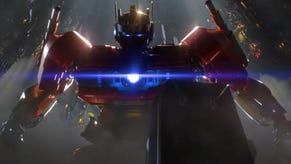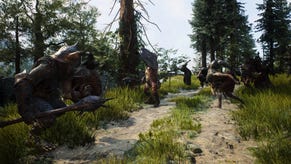Spielberg's Project LMNO ultimately failed because "it tried to do too much"
Project LMNO was supposed to make you cry. And it did. Just not in the way its creators - chief among them Steven friggin' Spielberg - were hoping for.
So, what happened?
"The game tried to do too much" is pretty much the gist of it, according to 1UP. Conceived as something of a partner-based first-person parkour adventure, Project LMNO hoped to create an exceedingly powerful bond between the player and an alien-like NPC character named Eve (pictured) who would not only assist you in combat situations, but grow and change based on your actions. On top of that, the game was set to be only two or three hours long - in other words, to focus on quality over quantity.
"It was never fully decided on, so basically that was what the team was pushing for," said one of 1UP's sources. "We wanted it to be really replayable, and to try and show players during the course of one playthrough -- hint to them that there was actually a lot of different things you could have done, and you could go back and have a totally different experience, and encourage them to really replay it a bunch of different times."
As you can imagine, lead designers Randy Smith and Doug Church were vehemently opposed to traditionally lengthy games, with Smith even going so far as to pen an Edge column on that very topic. However, between that somewhat revolutionary goal, an entirely new way of interacting with a videogame character, new movement options, and more - all wrapped up in an untested new IP - things began to unravel.
"The problem is, with a game like this - and any open-ended game; either an open-world game like Godfather, or an open-ended mechanically game like ours, where our levels wouldn't necessarily be like huge streaming cities but you could do a lot of different things with them - EA's methodology always kind of breaks down," said one source.
"In our case, we had this level that was supposed to be two/three minutes, but you could actually play it for like 45. You could play it for quite awhile and do a bunch of different things. The difficulty we were having was we were trying to coalesce all those different systems into like, 'Here's five minutes of play that's representative.' When you can do so many things, it's hard to say 'that's representative.'"
Then came the lay-offs. In 2008, much of the LMNO team was given its walking papers, and only a skeleton crew emerged from the rubble. They then hooked up with another EALA team and - under the leadership of executive producer Matt Sentell - LMNO was reworked into a more traditional game.
"It was supposed to basically be EA's take on Uncharted," said a former employee. "It was Uncharted set in a Spielberg universe."
Those plans, however, never came to fruition, as EA decided to take its show on the road - more specifically, the information superhighway, aka the Internet. As a result, the publisher purchased Playfish, laid off 1500 employees, and canceled a number of projects. LMNO - at that point known as "The Escape Artist" - was one such unfortunate casualty, as it lacked a true multiplayer component and didn't mesh well with EA's plans.
The rest, sadly, is history. Still though, if you'd like to further revel in what could have been, we highly recommend 1UP's feature. It's a lengthy read, but it's more than interesting enough to warrant the wordcount. If you only read one gaming-related feature this week, make it that one. You won't be sorry.









